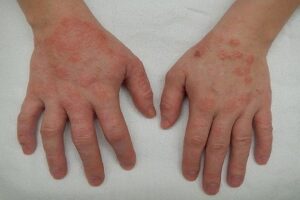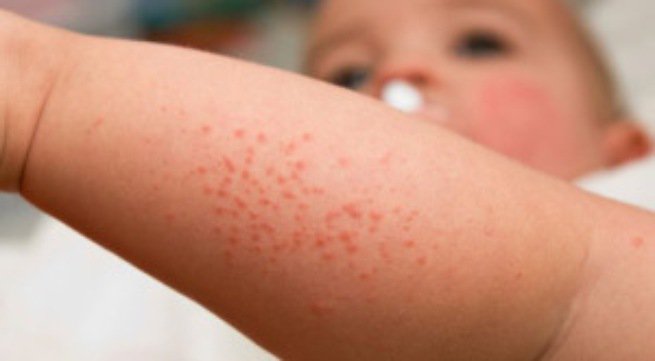Atopic dermatitis is a chronic skin condition characterized by dry and itchy skin, and is quite common in infants and young children, often first appearing when the child is 3 to 6 months old.
1. Causes of atopic dermatitis in children
The exact cause of atopic dermatitis is unclear, but several related issues include:
- Genetics: Skin issues may be related to the child’s parents.
- Immune system: An underdeveloped immune system may impact the protection of skin structures.
- External factors: Including cold weather, using water that is too hot when bathing, using soap, and living in dry, hot temperatures.
2. Who are the children at risk for atopic dermatitis?
Family members with atopic dermatitis or allergies.
3. Symptoms of atopic dermatitis in children?

Symptoms may appear or disappear at any time and can affect any area of the body. In infants, symptoms often appear on the face, neck, scalp, elbows, and knees. In older children, symptoms often affect the skin in the creases of the elbows, behind the knees, on the sides of the neck, around the mouth, and on the wrists, ankles, and hands.
Additionally, there are other symptoms such as:
- Dry, flaky skin
- Severe itching
- Redness and swelling
- Stomach issues
- Pale skin on the face
- Small raised bumps that can become brittle and leak fluid if scratched
- Rough bumps on the face, upper arms, and thighs
- Darkened skin of the eyelids or around the eyes
- Changes in the skin around the mouth, eyes, or ears
Symptoms of allergic atopic dermatitis may resemble other health conditions. To confirm, it is necessary to take your child to healthcare facilities for a clearer diagnosis.
4. When can allergic atopic dermatitis be diagnosed in children?
Healthcare centers will inquire about your child’s symptoms and medical history, symptoms of atopic dermatitis, asthma, or allergic rhinitis, and the presence of such conditions in family members.
Additionally, your child’s allergic symptoms are also very important in the diagnosis.
The healthcare center will look for signs of atopic dermatitis, specific allergy tests for your child; testing may not be strictly necessary in cases with clear symptoms but is sometimes crucial in difficult diagnostic cases.
5. Common tests used
- Blood test: Your child’s blood may be tested for IgE levels, a substance released by the immune system if your child has allergies and issues related to allergies.
- Skin prick test: Skin tests may be performed to check for allergies or other skin conditions; however, their accuracy is not very high, so they are often used infrequently in clinical practice.
6. How is allergic atopic dermatitis in children treated?
- Corticosteroid creams or ointments containing similar ingredients aimed at reducing itching and inflammation, swelling of the skin. Because these medications carry a risk of skin damage if used improperly, any misuse of medication and use not according to a doctor’s instructions is not recommended.
- Antibiotics: If the skin is inflamed and there is a high risk of infection, your child may need oral antibiotics along with topical antibiotics.
- Antihistamines: These are effective anti-itch medications when your child is itching due to allergic atopic dermatitis; they are often used before bedtime to help improve sleep and avoid being disturbed by itching.
- Topical or ointment medications that inhibit calcineurin help reduce itching and swelling, alleviating inflammation.
- Phototherapy: In some severe, resistant cases, phototherapy is proposed as part of supportive symptom reduction; it is typically used in older, cooperative children.
- Immunomodulating drugs: Medications that affect the immune system may be used in patients with resistant atopic dermatitis. Although these drugs can have a good therapeutic effect, they carry significant risks and many unwanted side effects, so they are not commonly used. Regular monitoring of test indicators is required when your child is prescribed medications in this group.
- Biologic medications: These are still under trial and are not recommended for widespread use.
7. What potential complications can arise from allergic dermatitis in children?
- Skin infections due to bacteria.
- Sleep disturbances, lifestyle issues, and they may lead to depression due to stress.
- Overuse of steroid creams can lead to many complications such as skin thinning and skin discoloration due to steroids.
8. How can I prevent the disease for my child?
- Avoid allergen triggers, common agents include: Wool, soap, chemicals, eggs, cow’s milk, dust mites, or pet dander. Sometimes stress can also be a triggering factor for allergies.
- Stop scratching the skin, try to keep your child’s skin from getting scratched as it can worsen symptoms and increase the risk of skin infections.
- Always keep your child’s nails short enough to avoid scratching the skin due to itching. Take warm baths, not too hot, quick baths lasting no more than 10 minutes, let the skin dry naturally or use a towel to gently pat the skin dry. Use moisturizer or moisturizing ointment after bathing.
- Wear soft, breathable clothing, and limit wearing dark-colored clothing to reduce the risk of allergic reactions to dye.
- Stay cool, try to keep your child in a cool environment, heat and sweating can exacerbate atopic dermatitis.
- Take your child for regular check-ups to assess skin damage and consult on maintaining moisture for your child’s skin.
9. When should parents take their child to the hospital to check for skin issues?
- Symptoms worsen.
- Signs of skin infection such as swelling and redness in the affected area with discharge, significant pain when touched, fever…
- Symptoms of dermatitis appear in new locations.

